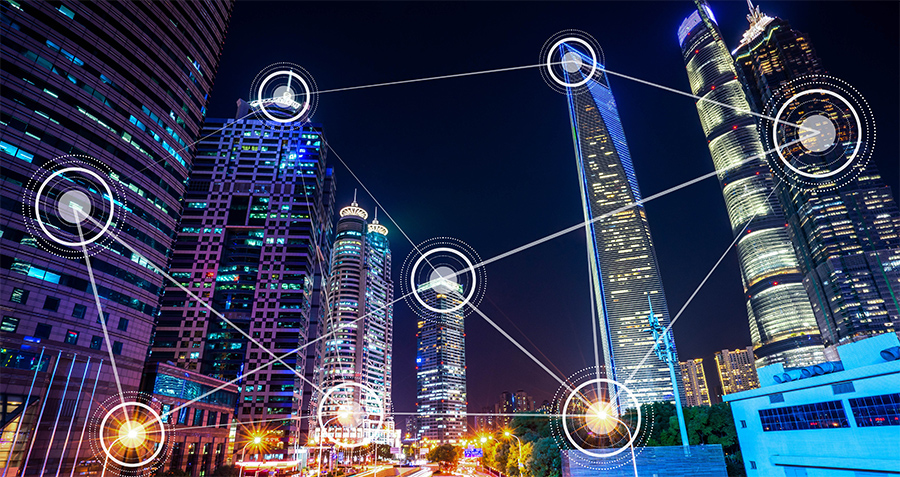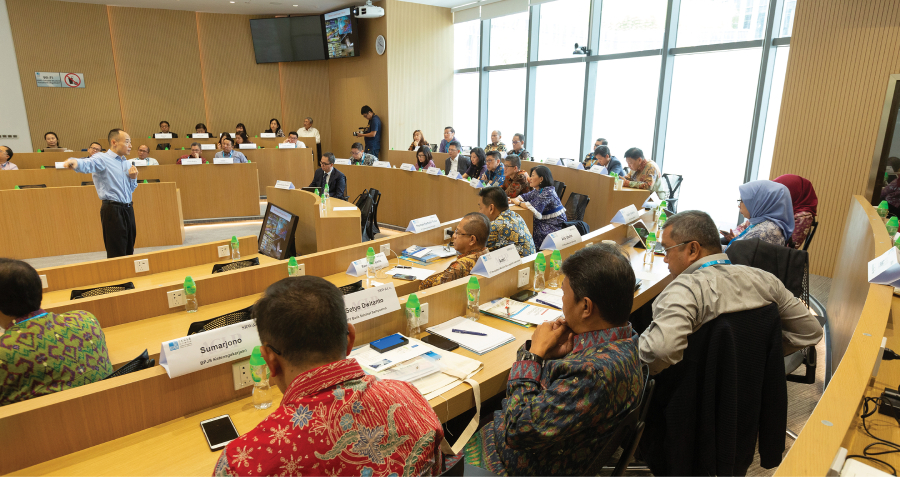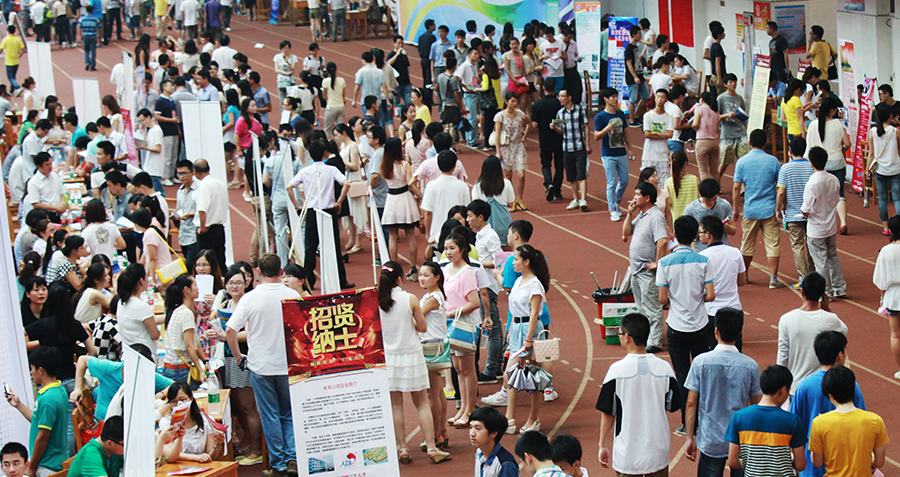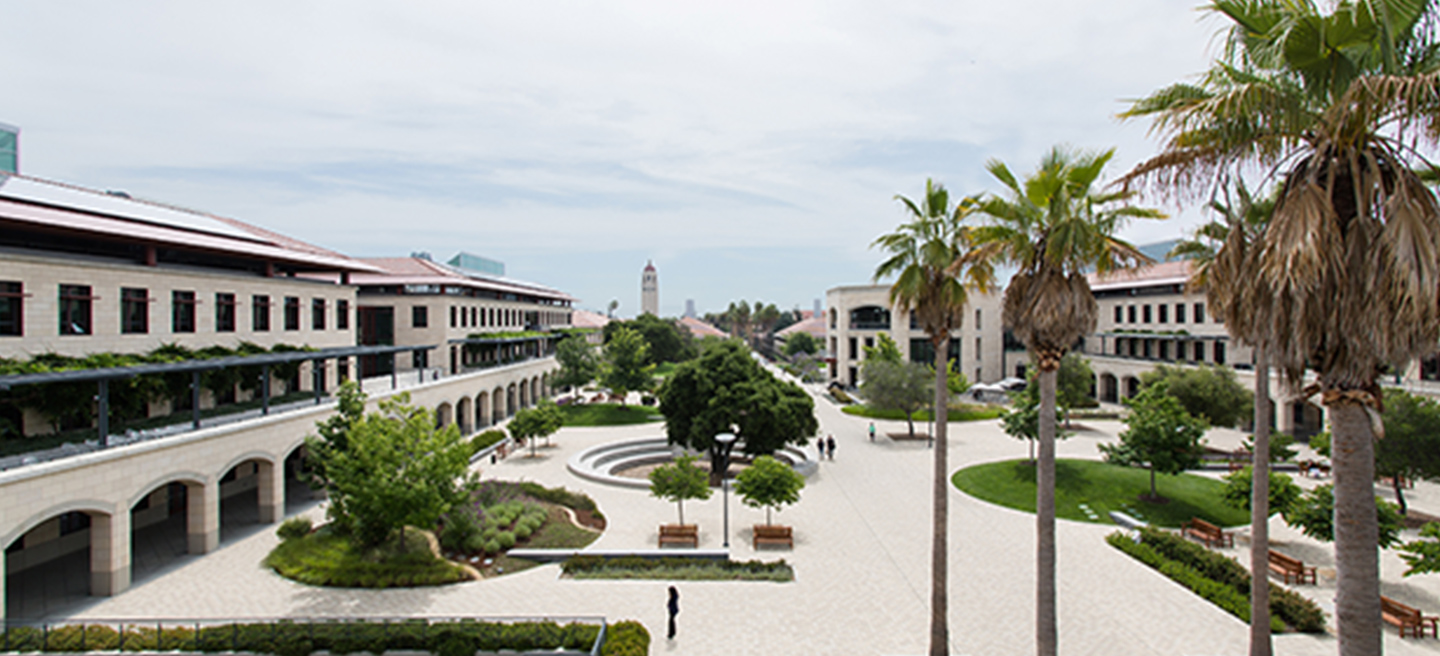Across a rapidly growing number of Chinese cities, an intricate web of technologies—AI, big data, cloud computing, IoT, blockchain, digital twins and augmented reality (AR)—work in sync to underpin what is known as a “city brain,” the core of today’s “smart cities.”
The “city brain” draws on a constant stream of data to better support city management and public services, such as shifting traffic signals in real time according to the flow of vehicles, regulating ventilation in skyscrapers according to the day’s weather or scheduling delivery runs for wheeled robots in underground, dedicated freight tunnels. And while all this may sound like science fiction, it has become a daily reality across China.
“Smart city development is a critical step for China’s urban centers as they pursue digital transformation and a new wave of productivity,” says Naifei Sun, Senior Associate Principal of SOM City Design Practice in Shanghai. “It lays the foundation for a more efficient, intelligent system of governance for our megacities.”
But despite the country’s successes so far, China’s smart city push also brings challenges—particularly regarding data security and personal privacy. And these concerns are increasingly cited as a barrier to China’s efforts to export its smart city technologies abroad.
Different visions, shared ambitions
At its core, a smart city utilizes the embedding of sensors, digital tools and advanced technologies into urban infrastructure. Through these tools, cities store, process and share digital knowledge and information, using data-driven approaches to guide urban governance.
While current figures remain elusive, a 2018 Deloitte report noted that more than 1,000 smart cities were in planning or development worldwide, with China leading the list with around 500 pilot cities, followed by the United States, Europe and India.
China’s smart cities are not limited to its mega-cities such as Beijing, Shanghai, Shenzhen and Hangzhou, and each city often prioritizes different smart aspects for implementation.
“Ten years ago, many Chinese cities were only exploring limited aspects of a smart city—for example, traffic data analysis and intelligent traffic light systems,” Sun says, adding that most of the smart city initiatives are far from holistic.
Shanghai’s effort to develop a “quantum space-time intelligent city,” according to Sun, is “the most comprehensive, systematic, and exploratory smart city framework” to date. This structure, known as “135981,” integrates digital twin technology, allowing simulation of governance decisions, ubiquitous sensing and virtual reality connectivity to replicate physical urban spaces and improve the quality of city operation, he adds.
Beyond Tier-1 cities, smart city projects can be implemented on any scale—from a single road, hospital or even a small digital screen to an entire urban area. For instance, when applied to buildings, smart city systems rely on Building Information Modeling (BIM) to enhance design and streamline operations. According to a report in 2025, BIM adoption among Chinese construction companies has reached 74.1% across core projects.
“Also, BIM will be a critical technology for measuring embodied carbon and improving energy and operational efficiency of buildings,” said Kenneth Rhee, CEO of Integral VIM, a Shanghai-based BIM consultancy.
Countries across the world share similar fundamental approaches to smart city thinking. From San Francisco to Paris to Beijing, city planners agree on the need to incorporate data-driven operations, low-carbon development, safety and efficiency into their blueprints.
“The strength of the different players within the smart city process differs for different countries and continents,” says Professor Martin de Jong, Scientific Director of the Erasmus Initiative “Dynamics of Inclusive Prosperity” at Erasmus University Rotterdam. “But the underlying capitalist drives are mostly the same.”
The differences lie more in the intended goals. A KPMG report in 2018 highlighted that China’s smart cities focus on enhancing urban oversight, strengthening infrastructure and upgrading economic structures, and this focus continues today. In contrast, the US is using IT infrastructure more to drive economic growth, while Europe emphasizes sustainable development and environmental quality through intelligent urban design.
A suite of technologies
From 5G networks to AI, a suite of technologies forms the backbone of China’s smart cities. Sensors embedded throughout urban infrastructure collect vast amounts of data, which are then processed via cloud computing and AI. But even high-speed 5G isn’t always enough. Edge computing—the practice of storing data closer to where it will be required—has become essential, enabling local processing for time-critical tasks.
Smart transportation illustrates this well: vehicle-to-everything (V2X) technology requires vehicles to process sensor data on board for immediate responses, while also interfacing with roadside data to support autonomous driving.
Earlier generations of information technologies, including big data and computer vision, have become well-established. Today, next-gen technologies, particularly large language models (LLM), are increasingly applied to enhance smart city governance, especially the delivery of public services.
Beijing’s public service Q&A platform has built-in LLMs that handle more than 100 queries per hour with 94% accuracy and double the efficiency of human operators, according to a 2024 Beijing Daily report.
Meanwhile, technologies like VR, AR and digital twins build bridges between virtual models and physical cities, allowing urban managers to simulate and predict real-world scenarios for better decision-making.
Energy is another focus. As urban populations grow and energy-intensive AI data centers proliferate, energy consumption has surged. In response, applications like smart grids and renewable energy integration have emerged to ensure energy security and optimize efficiency.
Combining AI with robotics, a sector China leads in, could also open up new opportunities in healthcare, education and transportation. “AI alone can analyze tons and tons of data, but in order to really make them flourish, you need [robots] to undertake physical action,” says de Jong.
Policy leads, market follows
On an organizational level, China’s smart cities are mostly government-driven initiatives, in a stark contrast to the West’s mostly bottom-up, private-led approach. In China, major business players involved in smart city drives span a broad spectrum: hardware and software manufacturers, telecom providers, internet firms, energy utilities and cloud computing companies. While industry participation is wide, the driving force remains the government.
“Unlike in the US, where Big Tech dominates the space, and in Europe, where a mixture of the public and private sector influences the money flows, in China the government’s influence on what happens to smart cities is comparatively larger,” says de Jong.
China’s push into smart cities began in earnest after IBM popularized the concept in 2008. By 2009, cities like Beijing, Shanghai and Guangzhou had incorporated smart city goals into their 12th Five-Year Plans. The initiative has since fit seamlessly into national strategies such as “Digital China” and successive Five-Year Plans.
“Smart cities have developed on the foundation of digital cities. In China, the construction of digital cities began with the establishment of urban network infrastructure,” says Yin Chengzhi, deputy Party chief at Tsinghua University’s School of Public Policy & Management. “As this infrastructure improved, city governments and businesses started building their own internal information systems to enhance efficiency and management capabilities.”
Historically, China’s smart city evolution has unfolded in three stages: Phase 1.0 (2009–2018) focused on building isolated digital systems with data silos and limited sharing. Massive data integration across sectors began in Phase 2.0 (2019–2023), when data was increasingly viewed as a strategic asset. During Phase 3.0 (from 2024 onward), data bureaus tasked with clarifying data ownership and usage rights cropped up to oversee data market development. As of June 2024, more than 80 data exchanges were in operation nationally, refining pricing, valuation, and trading rules.
China is actively promoting its smart city capabilities overseas, particularly in Southeast Asia, Africa, Central and Eastern Europe, and Central Asia. In the first nine months of 2024, it completed $142.99 billion worth of infrastructure contracts across Belt and Road Initiative countries, with digital infrastructure accounting for 35%, according to ChinaIRN.com, a market intelligence provider.
In Indonesia’s future capital, Nusantara, designed as a smart, sustainable city, Chinese firms like Huawei provide essential ICT services such as 5G infrastructure. Similarly, Central Asian countries are adopting Chinese smart city systems. At bus stops in Astana, Kazakhstan, real-time displays show arrival times to the second, backed by Dahua’s traffic systems, Huawei’s cloud computing and financing from the Export-Import Bank of China.
The surveillance trade-off
Smart cities offer greater efficiency and convenience, but not without trade-offs. In China, widespread use of surveillance cameras and data-collecting apps has placed citizens under near-constant monitoring. Systems like SkyNet help deter crime, yet they raise questions about individual freedom.
A 2020 survey conducted by Peking University’s Guanghua School of Management in collaboration with AI upstart Megvii found that Chinese citizens exhibited the highest level of tolerance for AI technologies such as facial scans, compared to respondents in Japan, Singapore, Germany, Saudi Arabia and the United States.
The study went on to point out that while Chinese participants reported the greatest concern for privacy overall, they expressed the least worry about privacy issues related to AI. The survey attributed this apparent paradox to “high levels of trust” in the government to handle citizens’ data responsibly.
Regardless of Chinese citizens’ tolerance for ubiquitous security cameras, concerns about surveillance have surfaced overseas, leading to politically charged discourses around the motives of Chinese AI companies. Some skeptics even question whether smart city technologies may grant China access to critical infrastructure in partner countries. In a report by researcher Valentin Weber, formerly with the London School of Economics, China’s “city brain” is described as too complex for importing nations to scrutinize, raising worries about its potential military implications.
Domestic risks tied to data security are also more immediate. China’s 2024 Digital Work Plan lists threats like large-scale data leaks, malicious attacks and unauthorized usage. Incidents involving theft of government data are on the rise, prompting cities to bolster cybersecurity efforts.
“Data should be managed through classification and tiered protection to ensure sensitive information is well safeguarded. Encryption should be used to protect data during storage and transmission,” Yin of Tsinghua says, adding regular data security audits are also recommended to help prevent risks such as leaks or tampering.
Another oft-repeated critique against smart cities is that it may widen the urban-rural divide. While cities benefit from rapid digital upgrades, rural areas often lag behind.
Globally, China increasingly finds itself competing with the West on smart city standards. “Europe and America will largely follow their own systems,” says de Jong. “But China is so far more successful in exporting its standards abroad.”
Looking ahead, China’s pace in building smart cities shows no sign of slowing. “Digital dividends” have enabled China to leapfrog Western countries in many areas, enhancing the livability, service quality and intelligence of its cities. Although concerns over data security persist, they can barely halt the evolution of smart cities.
Challenges down the road
After addressing data management issues, many urban planners expect the biggest challenges for China’s smart cities will come from climate change over the next 3–5 years.
“Buildings and urban infrastructure consume roughly around 40% of energy and are responsible for 40% of carbon emissions,” says Rhee of Integral VIM. “To combat global warming, the design, selection of building materials, construction methods and operation of buildings need to significantly improve in order to reduce embodied carbon in building materials and carbon emissions from operation of buildings. Also, limited availability of data is a key challenge.”
Besides environmental concerns, another hurdle is ensuring all participants can sustainably profit from smart city development, making it more enduring and robust.
“The challenge lies in building sustainable business models that bring tangible quality improvements to cities in specific application scenarios while allowing participating companies to earn profits that support ongoing investment,” says Sun.
At the end of the day, the future of smart cities in China will hinge not just on tech innovations, but on whether they can deliver value—and returns—for all players on board. And their success at home will likely reverberate far beyond the borders.




















